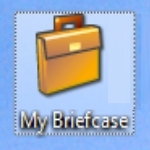
How to work with Microsoft Briefcase on a Windows PC
By Dave Taylor
The Question: I need to keep a set of files in sync across my laptop and desktop computer and a colleague told me that I should use Microsoft Windows Briefcase. I have no idea what that is or how to use it. What’s the scoop on Briefcase?
Dave’s Answer:
This is a question in the class of “thanks, I didn’t know about that either” and I have to say that while I’d seen Briefcase referenced in the Windows interface, I had no idea it was a slick, well-designed folder synchronization tool that worked across two devices whether they’re on the same network (the ideal) or whether you have to use an intermediary removable device like a thumb drive. Neat.
What’s better is that it’s built right into Windows 7 so there’s no software to download, no special utility to install, nothing you need to grab from Windows Live, etc. No third party apps = more secure and malware-free system = good. Very good.
There’s no magic cloud feature involved, however, unlike something like, say, Microsoft’s SkyDrive system (or Dropbox, a popular third-party alternative). This means that at some level, you have to do the work, but once you have it set up, all that entails is selecting “Update All” when you’re ready to sync. I’ll show you…
First step is to create a Windows Briefcase, which is done by right-clicking on the Desktop then selecting “Briefcase” from the “New” menu:

Article Continued Here
This post is excerpted with permission from Dave Taylor.
Sign up for Dave’s emails about free tech support and special offers on books, seminars, workshops and more.



